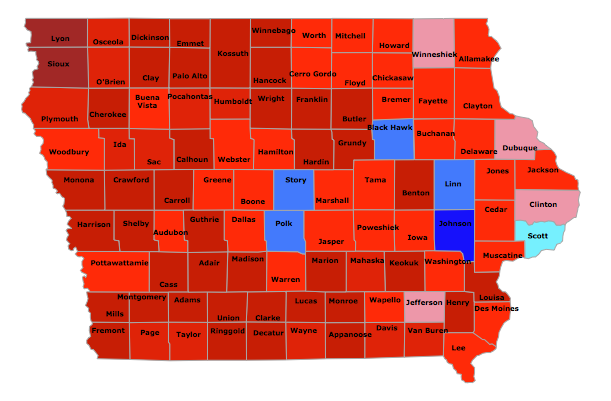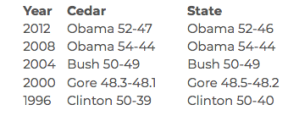Stephen Wolf of the Daily Kos Elections team compiled a spreadsheet of U.S. presidential election results by state, along with each state’s “partisan voting index,” from 1828 to 2016. The partisan voting index, developed by the Cook Political Report, shows “how strongly a United States congressional district or state leans toward the Democratic or Republican Party, compared to the nation as a whole.”
For six presidential elections in a row, Iowa’s top of the ticket results tracked remarkably closely to how the country voted. I say “remarkably” because demographically, Iowa’s overwhelmingly white electorate has not been representative of the U.S. population for many decades.
The streak was broken this year. So was the streak for Iowa’s best bellwether county.
Several Midwestern states provided the key to Donald Trump’s surprising win last week. The map of counties where Trump outperformed 2012 GOP nominee Mitt Romney showed a particularly pronounced swing toward Trump across the upper Midwest and “rust belt” areas of the northeast. In fact, Wolf noted today, “The Midwest hasn’t been as Republican relative to the nation as it was in 2016 since the 1944 elections,” when Franklin Delano Roosevelt defeated Thomas Dewey.
For more than a century after Iowa became a state, Iowans voted more Republican than the country as a whole in every presidential election. The state’s partisan voting index ranged from R+0 in 1932 (the year of FDR’s first victory) to R+13 in 1880 (when Americans elected the brilliant James Garfield).
Beginning in 1964, Iowa voters became a little less Republican-leaning, relative to the rest of the U.S. In fact, Lyndon Johnson defeated Barry Goldwater here by slightly more than his national margin, producing a Democratic PVI (D+1) for the first time in Iowa history. Not surprisingly, Democrats took control over both state legislative chambers the same year, leading to the creation of Iowa’s community college system and other major reforms in 1965.
Note that the partisan voting index does not reflect a candidate’s winning margin in a given state. Rather, it’s a way to measure a certain state’s voters compared to the rest of the country. For that reason, Iowa’s PVI shifted from R+6 in 1968 to D+3 in 1972, even though Richard Nixon won re-election here by a larger margin in 1972 than his advantage over Hubert Humphrey four years earlier. A solid majority of Iowans (57.6 percent to 40.5 percent) voted for Nixon over George McGovern. But Nixon’s re-election win was so dominating nationally that Iowa still had a Democratic PVI in 1972.
Iowa reverted to a slight Republican lean (PVI R+2) when voting for Gerald Ford in 1976 and Ronald Reagan in 1980. The farm and rural banking crisis can already be seen in the 1984 results, when Iowa had a PVI of D+5 even as our state voted to re-elect Reagan. He won here by less than 8 points, a much smaller margin than his national advantage over Walter Mondale.
The peak of Iowa’s Democratic lean compared to the rest of the country was D+9 in 1988, when Michael Dukakis won the state by 10 points and carried 75 (!) of the 99 counties. If you missed this post last week, click through to view the shocking county map from 1988. Even Sac County, the home base for Steve King, went Democratic that year.
Starting with Bill Clinton’s first victory, Iowa became a decent bellwether state: D+0 in 1992, D+1 in 1996, R+0 in 2000 (Gore carried the state, but by a slightly narrower margin than his national popular vote win), D+1 in 2004, D+1 in 2008, and D+1 again in 2012. In other words, our state voted just a little more Democratic than the country.
Now look at 2016: Trump’s win over Hillary Clinton by 51.2 percent to 41.7 percent gives Iowa a PVI of R+6. Texans voted for Trump by a slightly smaller margin than Iowans did, giving Texas a PVI of R+5.
The obvious explanation is that relative to the country, Iowa has a higher proportion of white residents without a college degree (Trump’s base).
The same factors may explain why Iowa’s best bellwether county lost that status in 2016.
Look at Cedar County’s results for the five presidential elections before this one:
This year, Cedar County voters backed Trump over Clinton by 55.5 percent to 37.7 percent. That’s a larger victory for Trump than one would expect based on the latest voter registration numbers for the parties. On the other hand, non-Hispanic whites make up 96.0 percent of Cedar County’s population, compared to 86.7 percent of all Iowans, according to the latest Census Bureau estimates.
Approximately 20.8 percent of Cedar County adults at least 25 years old have a bachelor’s degree or higher. For Iowa, the corresponding figure is 26.4 percent. Clinton’s vote share was higher among college-educated voters.
Cedar County also has a slightly larger proportion of residents over age 65 than Iowa does, which probably worked in Trump’s favor.
Any relevant comments are welcome in this thread.
Top image: 2016 presidential election results by county



1 Comment
Will Cedar County Swing Voters Swing Back?
I’ve heard the framing “bellwether Iowa” before and believe it is buncombe (H.L. Mencken spelling). To me the discussion should be about swing voters.
Here are my initial reactions:
The size of Trump’s win in Cedar County doesn’t matter to the operative condition of swing voting which is the culture of the electorate. The mathematical framework here seems arbitrary. As I’ve argued with prominent Democrats in Cedar County, mathematical analysis isn’t how one understands the electorate at the county level.
History matters less than the candidate or slate of candidates up for election. It is predictable that based on population, ethnicity and factors you mentioned, with the high number of no preference voters (4,586) compared to Democrats (3,173) and Republicans (3,902) Trump would do well. Many in the Clinton bubble, including me, underestimated how much people dislike Hillary and Bill Clinton. The Republican party strategy was hammer Clinton repeatedly then do it again and it worked to persuade swing voters to vote Trump in big numbers.
Cedar County voters were willing to split the ticket in 2012. To answer the bellwether question one has to understand whether they will swing back given a different set of candidates. I believe they will.
The elephant in the room is the Kaufmann family. Since Jeff ran successfully for Cedar County supervisor, and Bobby ran for state house, and their family has deep, multi-generational roots in the county, their influence is everywhere. The fact that Jeff Kaufmann was Republican Party chair this cycle mattered a lot to Trump’s high margin. Beginning with the caucuses he was able to activate voters for events in a way I believe gave Republicans a clear advantage in preparing for the general.
I don’t claim to be an expert on Cedar County, although I virtually lived there most of July – October of 2012. As long as the Kaufmanns sustain their hegemony it won’t be anything like a bellwether.
Paul Deaton
biggrovewalker Thu 17 Nov 6:52 PM